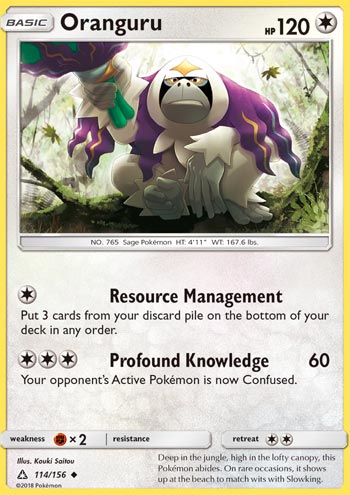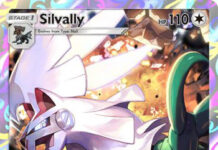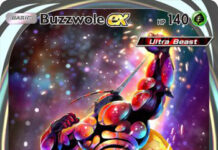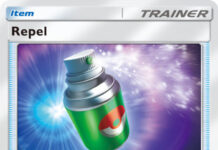
Oranguru
– Ultra Prism
Date Reviewed:
November 3, 2020
Ratings Summary:
Standard: N/A
Expanded: 4.00
Limited: 4.00
Ratings are based on a 1 to 5 scale. 1 is horrible. 3 is average. 5 is great.
Reviews Below:
 Otaku Oh, Oranguru (SM – Ultra Prism 11/156), what an interesting life you’ve lead. We first reviewed it here, on march 13, 2018. Then we looked at it again, on December 21, 2018: it was our pick as the 7th best new card of the year! I actually missed the original review, but in the second I made it clear that this was a good card, the star of a few control and/or mill archetypes, and a decent inclusion in general. I also made it clear that Oranguru had caught me off guard; before it actually happened, I’d dismissed Oranguru as niche use at best. Oranguru is a baseline Pokémon, worth just one Prize and containing no specialty mechanics. As a Colorless type, you won’t be attacking into Weakness or Resistance, and there’s not a lot of relevant, type-based support or counters. Oranguru is a Basic Pokémon, so it is easy to run and its 120 HP is decent, even though Oranguru is a little more likely to be OHKO’d than not. [F] Weakness often hasn’t helped it; it was good when Oranguru was Standard-legal and Expanded offers the type all its tricks. No Resistance is the worst, but also the most common. A Retreat Cost of [CC] is neither high enough to be a real problem nor low enough to be a bonus. Oranguru has two attacks. “Resource Management” costs [C] and lets you bottom deck three cards from your discard pile. The exact order in which they go is up to you, but it is always to the very bottom of your deck. If you want to access what you recycle, you’ll need a search effect, a shuffling effect (for a chance), or to be nearly out of cards. Which is what happened, but we’ll get into those details later. Oranguru can also attack with “Profound Knowledge” for [CCC]. This does 60 damage while leaving your opponent’s Active Confused. It should really cost more like [CC], but it has proven useful in tight spots. Resource Management just didn’t look that great; while Oranguru wasn’t super fragile, especially for a single Prize Basic, it was far from durable, either. I expected it could be sacrificed, attacking once to bottom deck three important cards, but as stated, you’d have to use a search effect if you wanted them back in a timely manner. You could also try your luck by using any effect which shuffled your deck so that subsequent draws had a chance of being those cards, without you having to run through all but your final three cards first. So, why not use search effects? Because universal search tends to be relatively pricey, and the easily searched cards (Pokémon and basic Energy) were also easily recycled by Item or Supporter effects. What I missed seems so obvious in hindsight. The deck that perhaps needs to constantly reuse cards the most are control decks. If you’re spamming control elements, Oranguru’s 120 HP is much less likely to fall to a OHKO. If they have enough copies of the card in question, or at least, enough alternatives, at least some of those decks actually can afford to just sit and wait until the recycled cards start turning up again later, because Oranguru itself isn’t being KO’d fast enough (if at all) for you to run out of cards. As for combos, we’ll start with Looker and Looker Whistle, as they released alongside Oranguru. You had to mind the timing, and it was vulnerable to your opponent disrupting your own hand or forcing you to shuffle your deck, but a simple “Looker Loop” meant you could recycle one copy of Looker plus two other cards the turn before, then play a second Looker the next turn to get all three from the bottom of your deck. Though I remember Oranguru/Looker decks being a “thing”… memories can be unreliable. Even contemporary experiences can be misleading, because something you remember (for example) being popular on the PTCGO may have lacked any recorded tournament success. Such is the case with Looker and Oranguru; I remember, it, but digging through several months worth of tournament results – when it was new – turned up nothing. Moving on, a few sets later, we received Magcargo (SM – Celestial Storm 24/168). Now, you had another option; use its “Smooth Over” Ability to top deck one of the cards you recycled last turn, then use any effect that added the top card of your deck to your hand without shuffling first, or otherwise precluded you playing what you topdecked e.g. not a Supporter if you were recycling and reusing a different Supporter. You were already likely using reusable, Ability-based draw with Oranguru, so this was a natural evolution for the deck. Eventually, we received Bellelba & Brycen-Man, allowing these decks – even in Standard – to go from “control” to “control/mill”. Bellelba & Brycen-Man forced both players to discard the top three cards from their deck, but Resource Management lived up to its name, letting you recycle anything vital that you discarded. You did have to know when to recycle what you discarded and when to focus on recycling important cards you’d simply used, like Bellelba & Brycen-Man themselves. I’m also not sure if this deck is an option in Expanded or not; Bellelba & Brycen-Man are Banned (with a pseudo-replacement on the way) in Standard; they’re not actually listed as Banned in the Expanded Format. I don’t believe there has been a major, Expanded Format event since back in February. While we’ve seen a few online events since then, they were for Standard, which means the Expanded metagame is more muddled than usual. As recently as a year ago, Oranguru-utilizing control decks were a big presence in Expanded. Once Sword & Shield, with the latest generation of cards and some rule changes came along, their use took a dip. They did not fall off the map, but instead of making the top cut, they were “only” making the top 5% (31st out of 540). Could just be a bad showing for one event, or it may have been the start of a new trend. Regardless, the powers-that-be finally decided it was time for Oranguru to go. Some of its former combo pieces were banned before it. Maybe that wasn’t enough. Maybe something in the next set, or at least, known to be in the works, was going to “break” Oranguru further, so it had to go. The often one-sided gameplay from thorough control decks is not enjoyed by many players, and the powers-that-be have been responding to that more and more; it is possible nothing significant changed, except those in charge deciding that enough was enough and Oranguru was going to cause problems as long as it was still legal. It isn’t too likely you’ll be using Oranguru in the Limited Format, but if you do have the chance and pull it, it is a nice addition for most decks. The nature of the Limited Format means that 120 HP and even the 60 damage plus Confusion from its 2nd attack are pretty valuable. You’re not going to get a control deck out of it, but even with only four Prizes, it can be worth letting Oranguru take a hit or three to recycle your best pulls. Profound Knowledge may even be able to do what I suspect was its intended job; Confusing your opponent’s Active so you can more safely use Resource Management. Its Colorless costs mean it can work in just about any deck, Mulligan builds being the obvious exception. Ratings
Oranguru’s ban is a hard one for me to read. I’d like to think it is an example of TPCi and TPC thinking at least one step ahead. The current top control deck – built around Trevenant & Dusknoir-GX – is taking a big hit from Milotic (XY – Flashfire 23/106) being banned, which could open things up for the Oranguru-backed control decks to resume their dominance. Hitting them as well opens things up for other strategies… I hope! 20201105 Update: Thanks to some feedback, I was challenged over the Looker versions of the deck actually having any notable competitive success. If they did, I couldn’t find proof. |
 Vince Coming Soon |
We would love more volunteers to help us with our Card of the Day reviews. If you want to share your ideas on cards with other fans, feel free to drop us an email. We’d be happy to link back to your blog / YouTube Channel / etc. 😉
Click here to read our Pokémon Card of the Day Archive. We have reviewed more than 3500 Pokemon cards over the last 17+ years!



